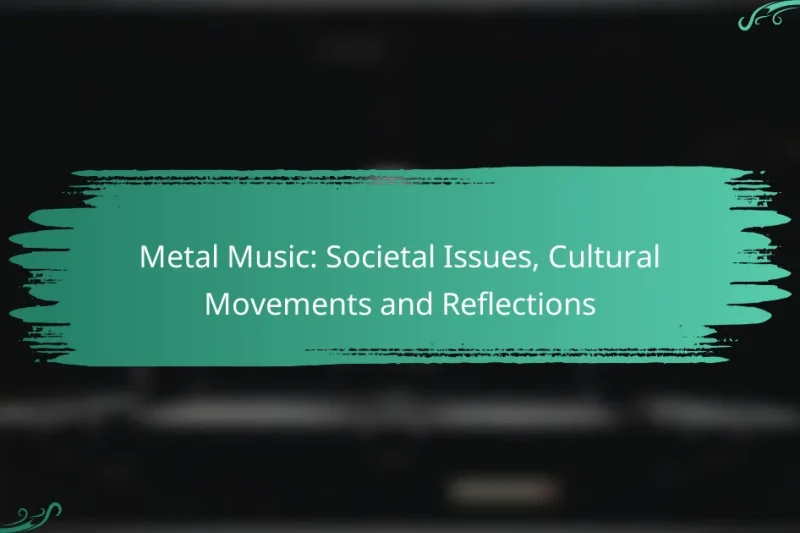Metal music memorabilia holds significant value for collectors and fans alike, making proper care and preservation … Metal Music Memorabilia: Care, Display and PreservationRead more
Metal music encompasses a diverse array of genres, each with unique characteristics and themes that resonate with different audiences. From the aggressive sound of Heavy Metal to the intricate styles of Thrash and Death Metal, the evolution of this genre reflects a rich tapestry of cultural influences and musical innovation. Understanding these genres allows fans to appreciate the complexity and artistry that define metal music.
Doom Metal: Characteristics, Key Bands and Listening Recommendations
Doom metal is a subgenre of heavy metal known for its slow tempos, heavy guitar riffs, … Doom Metal: Characteristics, Key Bands and Listening RecommendationsRead more
Metallica: Legacy, Influence and Modern Metal
Metallica has profoundly shaped modern metal music through their innovative sound and cultural significance, setting a … Metallica: Legacy, Influence and Modern MetalRead more
Metal Festivals: Navigating Large Events for Maximum Enjoyment
Metal festivals offer an exhilarating experience for fans, but navigating these large events requires some preparation. … Metal Festivals: Navigating Large Events for Maximum EnjoymentRead more
Vintage Metal Band T-Shirts: Best Sources and Quality
If you’re on the hunt for vintage metal band t-shirts, there are numerous online marketplaces and … Vintage Metal Band T-Shirts: Best Sources and QualityRead more
Metal Music: Film Soundtracks, Television Influence and Impact
Metal music plays a crucial role in shaping film soundtracks and television shows, adding intensity and … Metal Music: Film Soundtracks, Television Influence and ImpactRead more
Thrash Metal vs Death Metal: Key Differences and Listening Tips
Thrash Metal and Death Metal are two prominent subgenres of heavy metal, each offering a unique … Thrash Metal vs Death Metal: Key Differences and Listening TipsRead more
Download Festival: Evolution, Highlights and Future
Download Festival, held annually in the UK, has evolved into one of the premier rock and … Download Festival: Evolution, Highlights and FutureRead more
Metal Music: Societal Issues, Cultural Movements and Reflections
Metal music serves as a potent vehicle for exploring and critiquing societal issues, utilizing its aggressive … Metal Music: Societal Issues, Cultural Movements and ReflectionsRead more
Mixing and Mastering in Metal: Importance, Techniques and Tools
Mixing and mastering are vital processes in metal music, shaping the overall sound quality and enhancing … Mixing and Mastering in Metal: Importance, Techniques and ToolsRead more
What are the main metal music genres?
The main metal music genres include Heavy Metal, Thrash Metal, Death Metal, Black Metal, and Power Metal. Each genre has its distinct characteristics, themes, and musical styles that appeal to different audiences.
Heavy Metal
Heavy Metal is characterized by its loud, aggressive sound and powerful guitar riffs. Originating in the late 1960s and early 1970s, it often features strong vocals and a prominent rhythm section. Bands like Black Sabbath and Led Zeppelin are foundational to this genre.
Thematically, Heavy Metal often explores topics such as rebellion, fantasy, and mythology. The genre typically employs a 4/4 time signature and is known for its use of distortion and effects to create a heavy sound.
Thrash Metal
Thrash Metal emerged in the early 1980s and is known for its fast tempos and aggressive guitar playing. Bands like Metallica, Slayer, and Megadeth are key figures in this genre, which combines elements of Heavy Metal with punk rock's speed and energy.
This genre often features complex song structures and socially conscious lyrics. The drumming is typically fast-paced, utilizing double bass techniques that contribute to its intense sound.
Death Metal
Death Metal is recognized for its heavy use of distorted guitars, deep growling vocals, and complex song structures. It emerged in the mid-1980s, with bands like Death and Cannibal Corpse leading the way. The genre often incorporates elements of horror and the macabre in its lyrics.
Musically, Death Metal is characterized by its use of blast beats and intricate guitar solos. The genre can vary in speed, but it generally maintains a dark and aggressive tone throughout its compositions.
Black Metal
Black Metal is known for its atmospheric sound and often incorporates elements of darkness and mysticism. Originating in the early 1980s, bands like Mayhem and Burzum are pivotal to this genre. Black Metal typically features shrieking vocals and a raw production style.
Thematically, it often explores topics such as nature, paganism, and anti-religious sentiments. The music is usually fast-paced, with an emphasis on creating an eerie and haunting atmosphere.
Power Metal
Power Metal is characterized by its uplifting melodies and epic themes, often drawing on fantasy and mythology. Bands like Helloween and Blind Guardian are well-known in this genre, which emphasizes clean, high-pitched vocals and fast guitar work.
This genre typically features anthemic choruses and a symphonic sound, often incorporating keyboards and orchestral elements. Power Metal is known for its positive and heroic lyrical themes, making it distinct from the darker tones of other metal genres.
How did metal music genres evolve?
Metal music genres evolved through a combination of cultural influences, technological advancements, and the creative expressions of musicians. Starting from the late 1960s, metal has diversified into various subgenres, each with its own distinct characteristics and fan base.
Origins in the late 1960s
The roots of metal music can be traced back to the late 1960s, primarily in the United Kingdom and the United States. Bands like Black Sabbath and Led Zeppelin pioneered a heavier sound that combined rock elements with darker themes, setting the stage for future developments in the genre.
These early bands experimented with distorted guitar riffs, powerful vocals, and complex song structures, which became hallmarks of metal music. Their innovative approaches laid the groundwork for the genre's evolution in the following decades.
Influence of blues and rock
Blues and rock music significantly influenced the development of metal genres. The heavy guitar riffs and emotional intensity found in blues music were adopted by early metal bands, creating a unique fusion that resonated with audiences.
Rock music's emphasis on rhythm and melody also played a crucial role in shaping metal. Artists incorporated elements of rock, such as guitar solos and anthemic choruses, while pushing the boundaries of volume and aggression, leading to the emergence of distinct subgenres.
Development through the 1980s
The 1980s marked a pivotal decade for metal music, characterized by the emergence of various subgenres like thrash, death, and power metal. Bands such as Metallica, Slayer, and Iron Maiden brought new levels of speed, technicality, and theatricality to the genre.
This period also saw the rise of heavy metal as a mainstream genre, with increased radio play and the establishment of dedicated festivals. The diversity of styles during this time allowed fans to explore a wide range of sounds, from the melodic to the extreme.
What are the characteristics of heavy metal?
Heavy metal is characterized by its loud, aggressive sound, often featuring distorted guitars, powerful vocals, and complex song structures. These elements combine to create a genre that is both intense and dynamic, appealing to a wide range of listeners.
Distorted guitars
Distorted guitars are a hallmark of heavy metal music, providing a gritty and powerful sound. This distortion is achieved through various effects pedals and amplifiers, allowing guitarists to create a wide range of tones from crunchy to heavily saturated. Iconic bands often use drop tunings to enhance the heaviness of their riffs.
Common techniques include palm muting and harmonics, which add depth and texture to the guitar work. Many heavy metal songs feature intricate solos that showcase technical proficiency and creativity, further emphasizing the importance of distorted guitars in the genre.
Powerful vocals
Powerful vocals are essential in heavy metal, often characterized by a wide vocal range and intense delivery. Singers may employ techniques such as growling, screaming, or soaring high notes to convey emotion and energy. This vocal style complements the aggressive instrumentation, creating a compelling listening experience.
Vocalists often draw inspiration from various influences, leading to diverse styles within the genre. For example, some may focus on operatic techniques, while others might lean towards a more guttural approach, reflecting the band's overall sound and message.
Complex song structures
Complex song structures are a defining feature of heavy metal, often deviating from traditional verse-chorus formats. Many songs incorporate multiple sections, time signature changes, and varying tempos, which keep listeners engaged and showcase the musicians' technical skills. This complexity allows for greater storytelling and thematic depth within the music.
Some heavy metal compositions can exceed five minutes, with progressive metal bands frequently pushing the boundaries even further. This emphasis on intricate arrangements and musicianship is a key aspect that distinguishes heavy metal from other genres, appealing to fans who appreciate musical sophistication.
How do metal genres differ from each other?
Metal genres differ primarily in their vocal styles, instrumentation, and tempo variations. Each subgenre brings a unique sound and atmosphere, influenced by these key elements.
Vocal styles
Vocal styles in metal vary significantly, ranging from clean singing to harsh growls and screams. For instance, power metal often features soaring clean vocals, while death metal typically employs guttural growls. This diversity allows listeners to choose genres that match their preferences for vocal expression.
Some subgenres, like black metal, may incorporate high-pitched shrieks, adding an eerie quality, while others, such as doom metal, often use deep, resonant vocals to create a heavy atmosphere. Understanding these vocal styles can help fans appreciate the emotional depth of each genre.
Instrumentation
Instrumentation is another defining characteristic of metal genres. Traditional heavy metal usually includes electric guitars, bass, drums, and vocals, but many subgenres introduce unique elements. For example, symphonic metal incorporates orchestral instruments, while progressive metal often features complex time signatures and intricate guitar solos.
Additionally, some genres like thrash metal emphasize fast-paced guitar riffs and aggressive drumming, while others, such as sludge metal, may use slower tempos and heavier guitar tones. The choice of instruments and their arrangement significantly impact the overall sound and feel of each genre.
Tempo variations
Tempo variations play a crucial role in distinguishing metal genres. Many genres, like speed metal, are characterized by fast tempos, often exceeding 200 beats per minute, creating an energetic and intense listening experience. In contrast, genres such as doom metal typically feature slower tempos, often around 60-80 beats per minute, which contribute to a heavier, more oppressive sound.
Understanding these tempo differences can enhance your listening experience, as they influence the mood and energy of the music. Fans may gravitate towards faster tempos for an adrenaline rush or slower tempos for a more contemplative atmosphere.
What are the most popular metal bands in the US?
The most popular metal bands in the US include Metallica, Slayer, and Pantera, each known for their distinct sound and significant influence on the genre. These bands have garnered large fan bases and critical acclaim, shaping the landscape of metal music over the decades.
Metallica
Metallica is often regarded as one of the most successful heavy metal bands in history. Formed in 1981, they are known for their aggressive sound and complex compositions, with albums like "Master of Puppets" and "The Black Album" achieving massive commercial success.
Their music features fast tempos, intricate guitar riffs, and powerful lyrics, appealing to a wide audience. Metallica's influence extends beyond music, as they have played a significant role in popularizing metal culture in the US and worldwide.
Slayer
Slayer, formed in 1981, is known for their fast-paced music and dark themes, often exploring topics like war and violence. Their album "Reign in Blood" is considered a landmark in thrash metal, showcasing their signature sound characterized by rapid guitar solos and intense drumming.
Slayer's live performances are legendary, often featuring high energy and a dedicated fan base. They have left a lasting impact on the metal scene, influencing countless bands and subgenres.
Pantera
Pantera emerged in the 1990s as a key player in the groove metal movement, known for their heavy riffs and powerful vocals. Their album "Vulgar Display of Power" is a defining work, blending elements of thrash and southern rock to create a unique sound.
The band's dynamic style and intense live shows helped them gain a loyal following. Pantera's influence can be seen in many modern metal bands, making them a crucial part of the genre's evolution in the US.
What are the key festivals for metal music in Europe?
Europe hosts several prominent metal music festivals that attract fans from around the world. These events showcase a wide range of metal genres and feature both established and emerging artists.
Download Festival
Download Festival, held annually in the UK, is one of the largest and most recognized metal festivals in Europe. It typically features a lineup of major international acts along with a mix of up-and-coming bands, making it a must-attend for metal enthusiasts.
The festival usually takes place over three days in June at Donington Park, offering a vibrant atmosphere filled with live performances, merchandise stalls, and food vendors. Tickets often sell out quickly, so early booking is advisable.
Wacken Open Air
Wacken Open Air, located in Germany, is renowned as the world's biggest heavy metal festival. Every August, it attracts tens of thousands of fans to a small village in Schleswig-Holstein, creating a unique community vibe.
This festival features a diverse lineup that spans various metal subgenres, providing something for every fan. Attendees can enjoy not only music but also workshops, meet-and-greets, and a bustling market area.
Hellfest
Hellfest, held in Clisson, France, is celebrated for its eclectic lineup and stunning production quality. Taking place in June, it showcases a wide array of metal styles, from classic heavy metal to extreme subgenres.
With multiple stages and a rich festival experience, Hellfest is known for its impressive stage designs and immersive atmosphere. Fans often appreciate the opportunity to discover new bands alongside their favorite acts.
Graspop Metal Meeting
Graspop Metal Meeting, located in Belgium, is another key festival that features a mix of established and emerging metal artists. Typically held in late June, it draws a diverse crowd from across Europe.
The festival is known for its friendly atmosphere and well-organized layout, making it easy for attendees to navigate between stages. Fans can expect a variety of food options and merchandise stands, enhancing the overall experience.














